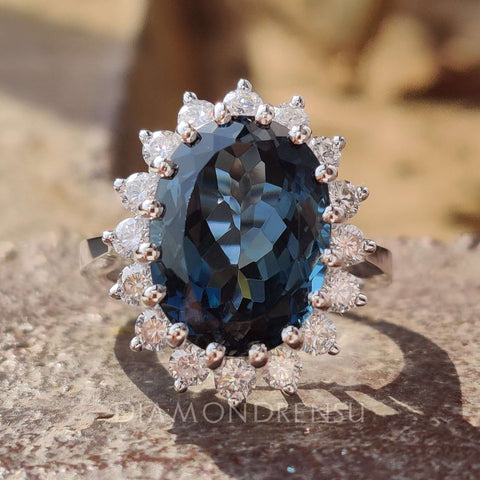
Best Diamond Alternatives: Affordable and Brilliant Choices for Jewelry
Diamond alternatives have gained popularity in recent years as more people seek affordable, unique, and eco-friendly options for their jewelry. These alternatives not only cater to a diverse range of personal preferences and budgets but are also gaining traction for their ethical and environmental advantages. As the demand for diamond alternatives continues to grow, it's essential for consumers to be confident and knowledgeable about the options available to them.

One of the driving factors behind the increasing interest in diamond alternatives is the ethical concerns surrounding the natural diamond industry. With the use of synthetic diamonds on the rise, these lab-grown options are not only more affordable but also have a significantly lower environmental impact, addressing some of the concerns associated with traditional diamond mining. These alternatives provide consumers with a clear and neutral choice that can be both stunning and conscientious.
In addition, diamond alternatives allow individuals to explore unique designs and styles that may not be possible or budget-friendly with natural diamonds. Options such as moissanite, cubic zirconia, and even gemstones like sapphire and emerald can provide a distinct appearance and character to any piece of jewelry. As consumers become more knowledgeable about the options available, they can make informed decisions on the best diamond alternatives that suit their needs and reflect their values.
Table Of Contents
Understanding Diamond Alternatives
When looking for an alternative to mined diamonds, it's essential to consider various factors, such as durability, appearance, cost, and ethical concerns. Diamond alternatives provide options for those who desire an engagement ring that has the same visual appeal as a real diamond without the hefty price tag or ethical issues surrounding conflict diamonds.
One popular diamond alternative is moissanite, a gemstone known for its brilliance and durability. Moissanite engagement rings come in various shapes, sizes, and designs, offering a beautiful and affordable option to mined diamonds. Besides its visual appeal, moissanite scores 9.25 on the Mohs scale of hardness, making it an incredibly durable choice for daily wear.
Lab-grown diamonds are another alternative that shares the same chemical and physical properties as mined diamonds. These man-made diamonds are created in a controlled environment using advanced technology, making them an ethical and eco-friendly choice. Lab diamonds provide the same sparkling appearance of a real diamond at a fraction of the cost.
Diamond simulants, such as cubic zirconia and white sapphire, are also popular alternatives. While they may not have the exact same properties as a natural diamond, these gemstones offer an affordable option for those looking for an engagement ring without breaking the bank. However, it's important to note that these diamond simulants may not be as durable as a real diamond or a lab-grown diamond, and they might lose their luster over time.
In conclusion, there are various diamond alternatives available for those looking for an engagement ring that suits their preferences, budget, and ethical concerns. By understanding the differences between moissanite, lab-grown diamonds, and diamond simulants, one can make an informed decision when selecting their perfect engagement ring.
Popular Diamond Alternatives

One popular diamond alternative is moissanite, a gemstone known for its durability and brilliance. It is made of silicon carbide and has a similar appearance to diamonds, but at a more affordable price. Moissanite is a great option for those looking for a budget-friendly yet stunning gemstone.
Another well-known diamond alternative is sapphires. These gems come in various colors, including the highly sought-after white sapphire, which closely resembles a diamond. Sapphires are not only beautiful but also durable, making them an excellent choice for jewelry.
Cubic zirconia is another popular alternative for those seeking a diamond-like appearance. Known for its affordability, cubic zirconia is a lab-created gemstone made from zirconium dioxide. Although not as durable as diamonds or moissanite, cubic zirconia offers a brilliant sparkle at a fraction of the cost.
Beryl is another option to consider, with varieties such as emerald and morganite. Emeralds are loved for their rich green color, while morganite has a delicate pink hue, making them eye-catching alternatives to diamonds. Similarly, topaz, which can be found as white topaz, offers a clear, diamond-like appearance, making it another suitable alternative.
Colorful options like opal, amethyst, and quartz can also be considered as diamond alternatives. Opal, with its unique play of colors, creates a stunning visual effect, whereas amethyst has a captivating purple hue. Meanwhile, quartz presents numerous variations of colors and forms, offering versatility in jewelry designs.
Lab-grown diamonds, also known as lab-created diamonds, are becoming increasingly popular due to their ethical sourcing and affordability. These diamonds are grown using advanced technology, making them an environmentally friendly and ethical alternative to mined diamonds.
In conclusion, there are numerous diamond alternatives available, ranging from moissanite to lab-grown diamonds. Each gemstone offers unique qualities that can appeal to different preferences and budgets. Whatever your choice, these alternatives provide a beautiful and affordable way to enjoy the sparkle and brilliance of a diamond.
Analyzing Characteristics of Diamond Alternatives
| Alternative | Hardness (Mohs Scale) | Brilliance | Fire | Color Range | Price |
|---|---|---|---|---|---|
| Moissanite | 9.25 | High dispersion and brilliance | Greater fire with colorful flashes of light | Nearly colorless with possible slight yellow or gray hues | More affordable than diamonds |
| Sapphire | 9 | Good brilliance and fire | Impressive fire with various colors | Various colors; blue sapphires are popular | Varies based on size and quality |
| Cubic Zirconia (CZ) | 8.5 - 8.8 | High brilliance but less fire compared to moissanite | Moderate fire with bright flashes | Available in a wide range of colors; often colorless | Highly affordable |
| White Topaz | 8 | Moderate brilliance with limited fire | Minimal fire with subtle flashes | Various colors; often colorless | Affordable |
Choosing the right diamond alternative requires analyzing various characteristics such as color, cut, clarity, luster, and hardness, among other factors. Being well informed on these characteristics ensures satisfaction when selecting an affordable, yet high-quality gemstone.
Color plays a significant role in determining the appeal of a gemstone. While some individuals may prefer traditional colorless stones, others may be attracted to gems with unique colors, such as red, pink, green, white, or yellow hues. Sapphire, for instance, is a popular alternative due to its stunning colors, as well as its excellent hardness—rated 9 on the Mohs scale of hardness, making it highly durable.
The cut of a gemstone affects its brilliance, sparkle factor, and overall symmetry. Precision in cutting is essential, as it determines how light interacts with the stone and highlights its visual appeal. Round brilliant cut moissanite is popular for its highly symmetrical and well-proportioned facets, which result in exceptional brilliance and fire.
Clarity is another critical factor when evaluating diamond alternatives. Clarity refers to the absence or presence of inclusions or blemishes within a gemstone. High clarity stones with minimal inclusions are more desirable, as they allow light to pass through unobstructed, enhancing their beauty. Cushion Divine Moissanite is an example of a gemstone praised for its flawless appearance and attractive luster.
Hardness is crucial for determining a gemstone's durability, as it influences its resistance to scratching and chipping. Measured on the Mohs scale of hardness, higher ratings indicate a more resilient stone. Diamond alternatives such as sapphire, with a rating of 9, or moissanite, measuring 9.5 on the scale, offer exceptional durability and are suitable for everyday wear.
The gemstone's refractive index and dispersion influence its sparkle factor and overall luster. Gemstones with higher refractive indices and dispersion rates emit more light and sparkle, giving them a more dazzling appearance. Diamond alternatives like moissanite are known for their high refractive index, which makes them an attractive option for those seeking brilliance within their budget.
In conclusion, considering color, cut, clarity, hardness, and other factors like refractive index and dispersion, helps individuals make knowledgeable decisions when selecting the best diamond alternative for their desired style and preferences.
Choosing a Diamond Alternative for Engagement Rings
When it comes to choosing an engagement ring, many people are exploring diamond alternatives due to various factors such as ethical concerns or budgetary considerations. One popular diamond alternative is the white sapphire. White sapphire is a durable, beautiful, and cost-effective option that maintains its sparkle and brilliance over time.
Another option is selecting a moissanite engagement ring. Moissanite has gained popularity for several reasons, including affordability and its stunning visual appearance. Moissanite engagement rings mimic the look of a diamond, with added fire and brilliance that are unique to the gemstone. In addition, moissanite is an ethical choice, as it is lab-grown and more environmentally friendly than mined diamonds.
Couples can further customize their rings with various ring settings or even choose Moissanite bridal sets that include a matching engagement ring and wedding band. Personalized engagement rings ensure that the style and design are unique to the couple, reflecting their individual tastes and preferences.
If you're looking for a vintage-inspired look, consider antique cut moissanite engagement rings. These rings feature uniquely shaped stones in settings that evoke different historical eras, offering a one-of-a-kind and memorable ring for your partner.
In conclusion, there are several diamond alternatives available for engagement rings, including white sapphires and moissanite, with varying degrees of ethical considerations and affordability. By exploring these options, couples can find the perfect center stone and ring setting to create a beautiful and meaningful symbol of their love.
Impact of Diamond Alternatives on the Environment

Diamond alternatives have gained popularity in recent years due to their affordability and eco-friendly nature. These alternatives, such as moissanite, offer a more sustainable option for consumers looking to make a responsible choice in their jewelry purchases.
One of the main environmental benefits of diamond alternatives is their sourcing. In contrast to traditional diamonds, which are often mined in ways that can lead to habitat destruction and ecosystem disruption, alternatives like moissanite rings are lab-created. This process requires significantly less energy and produces fewer greenhouse gas emissions. As a result, the environmental impact of diamond alternatives is considerably lower than that of mined diamonds.
Additionally, the origin of diamond alternatives can be traced more easily than that of natural diamonds, ensuring ethical and environmentally responsible practices. This level of transparency is particularly important for consumers who want to be confident in their choice of jewelry and its impact on the environment.
In summary, diamond alternatives offer a more eco-friendly and affordable option for consumers looking to minimize their environmental footprint while still enjoying the beauty and elegance of traditional diamonds. By choosing these alternatives, individuals can contribute to a more sustainable future and make a positive impact on the environment.
Diamond Alternatives in the Jewelry Market

The demand for diamond alternatives has been growing steadily, as customers are increasingly looking for ethical, sustainable, and economical options. There are several high-quality substitutes for traditional diamond jewelry that offer a similar brilliance and appearance while remaining more accessible and eco-friendly.
One such alternative is moissanite, a gemstone known for its close resemblance to diamonds. Moissanite has been gaining popularity in recent years due to its durability, affordability, and stunning luster. Its properties are similar to those of diamonds, making it an excellent choice for fine jewelry lovers. Designer moissanite collections with diamond accents are now available in various online stores, catering to customers who want stylish and trendy designs.
In addition to moissanite, lab-grown diamonds have also become an attractive alternative for those interested in fine jewelry. These diamonds are created using advanced technology that replicates the Earth's natural processes, resulting in stones with the same chemical composition, appearance, and properties as mined diamonds. Lab-grown diamonds are a more ethical and sustainable choice, as they do not contribute to the environmental and social issues associated with diamond mining.
Renowned jewelry brands like James Allen have started to embrace lab-grown diamonds and other alternatives in their collections, responding to the changing dynamics of the jewelry market. This shift has opened up new possibilities for people to access unique and affordable fine moissanite jewelry without compromising on their style.
Diamond alternatives are not just limited to rings but also extend to other accessories such as pendants, earrings, and studs. These options allow individuals to wear exquisite and sustainable pieces while showcasing their unique personality and lifestyle.
Heirloom jewelry is another example of sustainable and ethical diamond alternatives. Reusing and repurposing family jewels can be an eco-friendly and meaningful way to celebrate significant milestones, from engagements to anniversaries.
In conclusion, the variety of diamond alternatives in the jewelry market provides numerous opportunities for customers to make informed, sustainable, and ethical choices. From moissanite to lab-grown diamonds and heirloom pieces, these options are changing the way people acquire and wear fine jewelry.
Frequently Asked Questions
What are the top alternative stones for engagement rings?
There are several popular alternative stones for engagement rings, including moissanite, white sapphires, cubic zirconia, and lab-grown diamonds. Each of these options presents differing levels of quality, durability, and affordability, making them appealing for various reasons.
Which diamond substitutes are the most durable?
In terms of durability, moissanite and white sapphires are considered the most durable diamond substitutes. Moissanite has a Mohs hardness of 9.25, while white sapphires have a hardness of 9 on the same scale, making them strong contenders. Lab-grown diamonds also exhibit the same level of durability as natural diamonds, with a hardness rating of 10.
How do moissanite stones compare to diamonds in terms of quality?
Moissanite stones offer a high level of brilliance and fire, often outshining diamonds in these aspects. However, they do exhibit more color compared to diamonds, especially under certain lighting conditions. In terms of quality, moissanite stones are an excellent alternative to diamonds, providing a similar appearance and durability.
What are the main benefits of choosing diamond alternatives?
Choosing a diamond alternative presents several benefits, such as affordability, ethical sourcing, and a wider selection of options. Many diamond alternatives offer similar qualities to diamonds, yet they are more accessible due to their lower price points. Additionally, choosing lab-grown diamonds or other alternatives can provide a more ethically sourced option, as these materials avoid the issues surrounding conflict diamonds and environmentally damaging mining practices.
Are there any affordable options that closely resemble diamonds?
Cubic zirconia and moissanite are two affordable options that closely resemble diamonds. Cubic zirconia is less durable than moissanite or diamonds, but it offers a visually similar appearance at a significantly lower cost. Moissanite, on the other hand, offers higher durability and a closer resemblance to diamonds in terms of brilliance and fire.
How do diamond alternatives differ in terms of price and appearance?
Diamond alternatives vary widely in price, with cubic zirconia being the most affordable option. Moissanite, white sapphires, and lab-grown diamonds also vary in price but are generally more expensive than cubic zirconia. In terms of appearance, moissanite and lab-grown diamonds come the closest to mimicking the look of natural diamonds, while white sapphires offer a more distinct appearance with a softer sparkle.
Checkout some of our top collections:
Leave a comment
Please note, comments must be approved before they are published.













